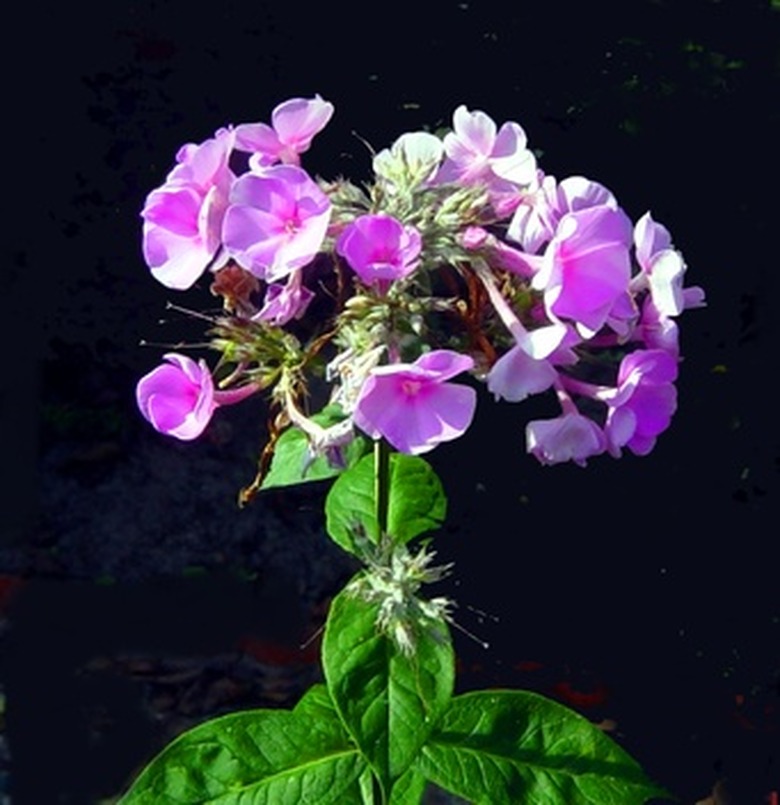How To Plant Tall Phlox
Things Needed
- Garden shovel
- Compost
- Watering can/hose
Tall phlox (Phlox paniculata) brings fragrance and flower color to perennial borders and cottage-style gardens in summer. It's sometimes called perennial phlox, garden phlox or fall phlox to differentiate it from the sprawling, spring-blooming species. Numerous hybrid varieties exist and grow successfully in USDA hardiness zones 4 through 8. Container-grown plants transplant well anytime soil can be worked, but mail-ordered bare-root plants must be planted in the spring.
Step 1
Plant your phlox in an area with fertile, well-draining soil that remains moist during the growing season. Avoid areas that flood after rains or remain soggy for hours; don't choose a hot, dry soil either. The location also needs at least four hours of direct sunshine daily, more if possible, to ensure lush plants and the best flowering displays.
- Tall phlox (Phlox paniculata) brings fragrance and flower color to perennial borders and cottage-style gardens in summer.
- The location also needs at least four hours of direct sunshine daily, more if possible, to ensure lush plants and the best flowering displays.
Step 2
Remove any weeds or rocks from the planting area, using the garden shovel.
Step 3
Mix in compost or well-cured manure into the top 6 to 12 inches of topsoil. Tall phlox's roots grow relatively shallowly, and having a fertile soil promotes best plant performance. Adding the organic matter also improves drainage, especially in clay soils, and helps retain moisture in sandy soils.
Step 4
Dig a planting hole no deeper than 10 inches and about twice as wide as the root ball of the tall phlox.
Step 5
Turn the container over and jiggle the plant out of it. Gently rest the plant in the hole. Match the top of the root ball with the top rim of the planting hole. Add or remove soil from the hole as needed to ensure the root ball top matches the soil line.
- Remove any weeds or rocks from the planting area, using the garden shovel.
- Add or remove soil from the hole as needed to ensure the root ball top matches the soil line.
Step 6
Scratch and loosen tightly bound or wrapping roots at the base of the root ball so that some of them dangle freely from the root ball. Try to loosen the root ball in three to four areas.
Step 7
Replace soil around the root ball, gently tamping soil down around the roots until the hole is full. Make sure the root ball's top remains at the same level as the soil line at the top of the hole. Reset the plant if it rests too low in the hole.
Step 8
Form a small rim or berm of excess soil around the tall phlox to act as a catch-basin for water. Apply 3 to 4 inches of water from a watering can or garden hose. This watering compacts the soil, removes air pockets and ensures soil particles come in contact with plant roots.
- Scratch and loosen tightly bound or wrapping roots at the base of the root ball so that some of them dangle freely from the root ball.
- Make sure the root ball's top remains at the same level as the soil line at the top of the hole.
Step 9
Add 1 inch of water to the catch-basin every day for the next week. Taper off watering gradually during the first month so that the tall phlox transplant receives 1 to 2 inches of water every week, including rainfall.
Tip
Bareroot plants must be planted at the proper depth so they neither dry out or rot and suffocate. Look at the transition area on the plant where the clean base of the stem changes color and looks soiled. This "crown" area reveals where the soil must be once the plant is in the ground. Tall phlox clumps need digging and dividing every three to four years to maintain flowering vigor. In cold winter regions, divide plants in early spring as soon as soil can be worked after the frost leaves. Elsewhere, cut back stems to 1/2 their height after flowering and make the transplants in mid- to late summer.
Warning
Monitor the soil around the newly planted tall phlox for the first one to three months. You don't want the plant to dry out and die. Keep the soil moist, but do not overwater. Water the soil around tall phlox, not the leaves. Wetting the leaves leads to fungal diseases.
